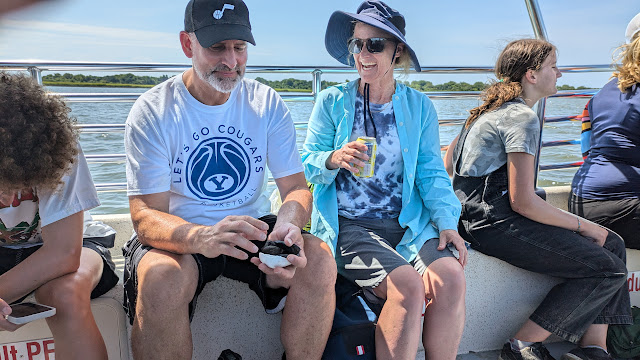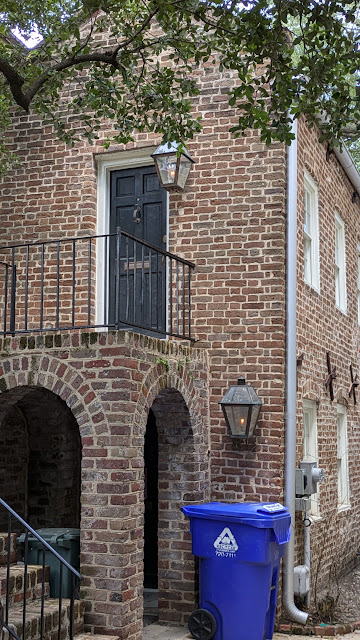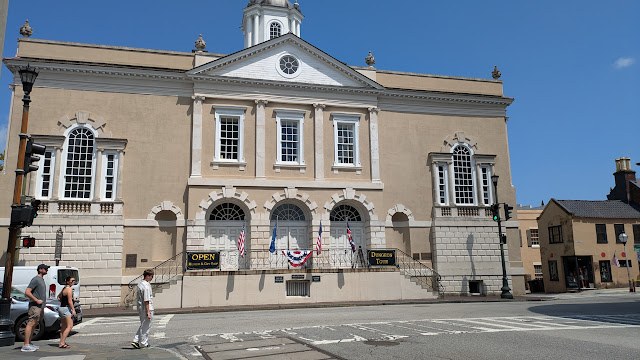Sad news of the passing of kind, smart, level-headed 56 year old Susan Wojcicki, leader at Google and CEO of You-Tube. I have long-admired the Wojicki family, friends of my kids in Palo Alto.
What an amazing Olympic Games, with spectacular performances by so many outstanding athletes...competitive but bringing together this often too disconnected world. I especially loved the track and basketball events, but love it all!
Sara Gilman and I flew from hot (but still beautiful) Utah to the pleasant California Bay Area
and to attend the wonderful memorial service for Monajo Ellsworth, who had such an impact on many of our lives. Below among others are her wonderful children: Marie and Ann (3rd and 4th from left), Michelle and John (extreme right).
Top: Sue Allen, Ludwiga, Nanci, Marguerite Hancock;
Lunch beside the bay in Sausalito after the morning in one of my favorite places in the world...Muir Woods in Marin County....with my brother Roy and sister-in-law Julie who recently moved into their beautifully remodeled home near the campus in Berkeley.
"When we try to pick out anything by itself, we find it hitched to everything else in the Universe." - John Muir
A leaf, a flower, a stone—the simple beauty of nature filled John Muir with joy. Muir shared his love of nature through writing and inspired people to protect our country's wild places, fueling the formation of the National Park Service and the modern conservation movement. Muir loved all things wild and saw humans as one small part of nature. He valued the natural world not only for economic gain, but for its beauty and healing powers. Muir championed the revolutionary idea that wild spaces should be set aside for all to enjoy.
John Muir was born on April 21, 1838, in Dunbar, Scotland, to Daniel and Ann Gilrye Muir. His father was a strict disciplinarian, and young John often found solace in the countryside. His grandfather, a nature lover, would take him on walks through the Scottish countryside, fostering his early appreciation for nature.
In 1849, when Muir was 11, the family immigrated to the United States, settling in Wisconsin. They started a farm, and Muir's nature lessons continued amidst the American wilderness. Despite his father’s insistence on hard labor and religious study, Muir managed to invent mechanical devices and immerse himself in the study of nature. He enrolled at the University of Wisconsin in 1860, where he studied biology, botany, and geology, laying the academic foundation for his future explorations.
In 1945, delegates from all over the world met in San Francisco to write and sign the charter of the United Nations. They gathered in Muir Woods to honor FDR, visionary of the UN, who had died a month before. He believed that National Parks and attention to forests and ecology promote peace. Teddy Roosevelt, his distant cousin and whose niece was Eleanor Roosevelt, was also a strong proponent of wilderness and parks.
to art (Notre Dame Cathedral, and Greek and Roman art), to heroines of the Old Testament...
to neurodiversity and Mindfulness (taught by my daughter Emily)
To tips for supportive grand-parenting
To many Gospel topics
To religious art by Heinrich Hoffman
To the 12 Tribes of Israel and much much more! (This old clock is on the Western Wall in Jerusalem).
At the reception at Grand America Hotel in Salt Lake City: Elsie with her mom and brother. Several guest came all the way from Africa.
and the funeral of friend Bob Galbraith from Palo Alto. The family moved from California to Kaysville several years ago, but there were many old friends in attendance. Bob was an incredibly talented musician, playing violin with the San Francisco opera orchestra and organ and other instruments for years. He was also extremely kind, loved to build, and had a nice sense of humor. His dear wife Janet played my favorite piece, Ashokan Farewell, written in 1982 for Ken Burn's Civil War documentary, but in the waltz style of a Scottish lament. She's an exquisite violinist also.
" She passed peacefully in her sleep, just as she hoped. Since her cancer diagnosis in November 2022, we have treasured the tender and joyful time we have been able to spend together with her. Here is one of her favorite poems:
On Becoming a God Adonis Remembers the World
Of all I leave, most beautiful is the sunlight.
Next come stars at nightfall, and the moon's face,
and in season, peaches, muskmelons, and pears.
Praxilla, 5th Century B.C.E.
There will be no public funeral. Each person is invited to have their own personal memorial of Sue, the way she would have wanted it."





















































































































